
 |
|
|
#1 |
|
Arms Historian
Join Date: Dec 2004
Location: Route 66
Posts: 10,730
|
Recently the discovery of Captain Kidd's ship, the "Quedah Merchant" near what is now the Dominican Republic, has revisited my interest in the weapons used by 'pirates'. Naturally, all the standard cliche' images come to mind, from "Treasure Island "to the "Pirates of the Caribbean" immersed pop culture.
Trying to research the weapons actually used by varied groups that fall into this genre over different time periods, and quite literally over the 'seven Seas', reveals pathetic amatuer treatises on the weapons used, especially the swords. I think the diffusion of various forms of ethnographic weapons was in many cases greatly enhanced by not only trade routes, but by these maritime franchises of either criminals or often 'licensed predators' carrying letters of marque, constantly moving between continents and oceans. I began the thread on early makers marks in hopes of investigating, discussing and comprehensively grouping these inscriptions, stamps and marks that typically occur on European blades and those intended for trade. This of course addresses diffusion of weapons via commercial means into ethnographic regions, however the admittedly more restricted scope of such movement via this interesting maritime phenomenon may produce some colorful and fascinating results. For example, pirates were of course not just the now cliche' Treasure Island characters of the American east coast and the Caribbean, and plundering the merchant ships of India, France, Spain and other powers...but the corsairs of the Meditteranean, Barbary Pirates, the pirates of the South China Sea, those of the Philippine and Indonesian archipelagos. Even India had thier own nautical renegades, such as those from the west coast in the Maratha pirates, who preyed on East India Company ships among others. With this geographic and cultural diversity, I am hoping that all members of the forum, in all factions of interest, might find interest in this topic, as weapons from all these cultures are in fact the true weapons used on so called 'pirate' vessels. It would not be surprising to find that among the composite armories on these ships, would be the acquired weapons from the prey they had taken. In the Indian Ocean, naturally along with the English hangers (not necessarily 'cutlasses') that were on the English/American pirate ships, could also have included tulwars, firangi, shamshirs (the literary 'scimitar' which is a writers term not an actual weapon) and others. I would like to discuss not only the more commonly associated cutlasses, hangers, rapiers, broadswords etc. but perhaps discover references seen in narratives of Philippines, China, India, Madagascar, Africa and others of piracy and perhaps references to the weapons. I think one of most comprehensive and accurate studies on the truly wide range of piracy and the weapons used was in a brilliant exhibition that was in Haifa, and the catalog produced was magnificent. I hope Oriental Arms might read this and help me recall the title and year as it is not at hand at this time. Best regards, Jim |
|
|

|
|
|
#2 |
|
Member
Join Date: Jan 2006
Location: Kent
Posts: 2,658
|
Hi Jim,
what an excellent idea, I'll try and do some 'digging' (NO treasure map) and see what I can find.  I do know that it was common to shorten the blades of captured swords to improve their 'functionality' on board ship. I do know that it was common to shorten the blades of captured swords to improve their 'functionality' on board ship.Kind Regards David |
|
|

|
|
|
#3 |
|
Member
Join Date: Dec 2004
Posts: 1,712
|
Fascinating Subject Jim! I to presume they would use any captured piece that took thier fancy or was fittest for the job.
The exhibition was called ... " Pirates - The Skull and Crossbones." The published works of the exhibition at The National Maritime museum, Haifa, Israel, were published in 2002. But sadley I havent any seen of the catalouges. Spiral |
|
|

|
|
|
#4 |
|
Member
Join Date: Dec 2004
Location: Virginia
Posts: 520
|
Jim
A while back I told you about a sword at a resturant in Charleston called "Queen Anne's Revenge" (for obvious reasons). As I am sure you know Charleston's pirate history is extensive. The owner there has been collecting pirate artifacts for a good while (I am told decades) and has many of them on display in the resturant. The one I wrote of on here had a Nimcha ( Saif ) hilt and a blade from what looked to be a takouba. There are more than a dozen other swords on display there some are indeed hangers. I do not have photos from there but there are video tours from a news clip on the resturant here under the tours section that give a brief view of some of them. http://www.qarevenge.com/ The priates soul museum in key west may be a good contact as well. They have a large collection but not many online photos of it http://www.piratesoul.com/contact.aspx While not all pirate the National Maritime Museum online collection is here and contains over 300 edged weapons, thats 300 online I think and more than 600 in its total collection (BTW they have a link on their page to this site ) http://www.nmm.ac.uk/collections/exp...tegory/weapons Last edited by RhysMichael; 18th December 2007 at 12:32 AM. |
|
|

|
|
|
#5 |
|
Arms Historian
Join Date: Dec 2004
Location: Route 66
Posts: 10,730
|
Thank you so much for the great responses guys!!! I really do think we can have some fun and exciting adventure with this topic!
You're right David, they did shorten down the blades on a lot of these weapons...wasn't a lot of room to wave around a three or four foot sword on those tiny decks!  Spiral, thanks for the name of that exhibition. I wish I had the copy of the catalog handy right now....it was an incredible reference, and most impressive accuracy. Maybe Artzi will read this and might have suggestions about copies. Rhys Michael, I am determined to get to Charleston one of these days and think that will be on the GPS soon. Excellent links BTW ! Thank you! During the earlier dives on the "Queen Annes Revenge" I had a number of great conversations with Wayne Lusardi and we often joked about the finds because I always grumbled about the cannons...where are the swords I said!! Dont think they ever found any. There were some distinct finds on the "Henrietta Marie" I believe with a shellguard English hanger, and on the "Whydah" I think there were some. The book "Swords for Sea Service" (2 vol) by May & Annis has great illustrations of many of these swords from the National Maritime Museum. Its been a while since that saif with the takouba blade! but what a great example of the great diversity of weapons used in the mkany forms of piracy. One book that comes to mind here that has great references on this topic is "Boarders Away" by Gilkerson. One weapon that seems to come up in illustrations of pirate weapons, but is seldom focused on, is the Scottish basket hilt. It has been established that Blackbeard was actually dispatched by a blow by one of these, but it seems that a Highlander who had joined with British expedition chasing him was simply aboard at the time, not necessarily regularly at sea. Any thoughts on whether the basket hilt was actually employed at sea? One thing that has really inspired me to address this subject on pirate swords is these pirate websites that inevitably show the brass basketguard 'cutlass' which is actually a M1860 U.S. naval cutlass of Civil War period. I think Wyeth perpetrated this is some of his otherwise magnificent illustrations. While obviously European and British hangers of the mid 17th century prevail as those used on pirate vessels, thier adventures into the waters of the Arabian Sea and Indian Ocean surely provided them with many forms of exotic weapons. Elgood shows karabela hilt nimcha with widened blade tip that may well have been used at sea by pirates from Muscat and others. So many possibilities!! All very best regards, Jim |
|
|

|
|
|
#6 |
|
Member
Join Date: Oct 2007
Posts: 2,818
|
Great thread Jim, I love them there pirates....hence my handle, Freebooter.
As with the trademark thread, just not a lot of time this time of year but I will leave you all with these images of an Executioners axe from the Danish West indies. I bid with fury on this many years ago but just didn't have the coin to win at the time. The images of the gallows and the wheel on this axe are very sinister, the gallows I am sure we all know about, but for those who have not seen the spoked wheel before, don't confuse it with a makers mark. This wheel was a horrible things. For further reading follow this link http://en.wikipedia.org/wiki/Breaking_wheel This particular group of images is what pirates were on the receiving end of if they were ever caught. Last edited by freebooter; 18th December 2007 at 09:21 AM. |
|
|

|
|
|
#7 |
|
Member
Join Date: Jan 2006
Location: Kent
Posts: 2,658
|
Hi Jim,
due to the close proximity of combatants on the decks of a ship, it is my understanding that basket hilted swords (European pirates and Privateers) were favoured, not only for the protection of the hand ( a crew with badly injured hands would have great difficulty in 'sailing ship') but also to strike your opponent,to stun ....before the coupe de gras. It seems that the cutlass blade was favoured for its weight (which was comparable to longer blades.) A basic functional 'chopper' suited to its use. Apparantly the Barbary pirates favoured the Nimcha, however I cannot find any pictures or any reference to the dimensions of the blades.  A link to other pirates or those considered pirates.... http://www.national-army-museum.ac.u...ks/page2.shtml Was hoping that the flags used by pirates might provide clues....nothing conclusive (a number of weapons shown) so far but this gives a little more 'background' http://pvcbanners.co.uk/world-flags/...s/pirates.html Regards David Jim, interestingly the first flag has latin (?) similar to early makers marks  . Last edited by katana; 18th December 2007 at 04:32 PM. |
|
|

|
|
|
#8 |
|
Member
Join Date: Oct 2007
Posts: 1,650
|
Hello,
Here's a blade I picked up a while ago and although probably dating from the latter half of the 18th Century, well after the pirate "golden age", I think it illustrates quite well the type of weapon most associated with buccaneers and pirates. The blade is 26 inches long pretty sharp and is most likely from a Government issue cutlass/hangar type weapon, the GR mark. If the makers mark on the tang rings a bell with anybody please let me know. Any more info or corrections, again, please let me know. Regards, Norman. |
|
|

|
|
|
#9 |
|
Arms Historian
Join Date: Dec 2004
Location: Route 66
Posts: 10,730
|
Freebooter, I figured that was behind your well chosen handle!!! I think we all have a certain curious affinity for these rascals! at least in the romanticized sense.
Your post with that fearsome looking axe surely adds some perspective to the darker side of the actual piracy phenomenon, and the markings are most intriguing as we have noted the appearance of similar marks on early executioners swords. Thanks very much for posting this, something not often seen in these discussions! David, well said on the favor for well guarded hands on the close quarters melees on deck, and all manner of basketed, shell guarded edged weapons were chosen. There was little 'fencing' or 'styled' sword combat, typically more of a street fighting anything goes scrap, though many 'pirates' had been seamen in various navies. As you note, the flags, while intriguing, offer only stylized hints of the weapons actually used and were used for emphasis symbolically. The letters do seem to represent first letters of some saying or phrase, probably well known to the men who used it, but unknown to us at this point. It does indeed fall in line with this practice on sword blade markings. Sets the mind to wondering what in the world it might have meant. It seems interesting that very similar defiance and rebelliousness is seen today in tattoos, biker symbolics etc. These guys were basically seagoing versions of todays rebellious subcultures. The nimchas were of course used in degree by the Barbary pirates, which were actually confederations of groups along the littoral in North Africa from Morocco to Algiers and Tunis. These 'nimchas's (actually sa'if) were among the many forms of edged weapons probably used, and as you note, there was considerable variation in the blades but most were of full length, suggesting these might have been used more in shore assaults. Norman, Thank you for joining us here, and I've very much enjoyed the weapons you have been posting on the other threads! Great examples, as is this one, which is as you note, a heavy cutlass type blade from the 1790's to early 19th century. This would probably have been mounted with the regulation naval disc hilt (see "Boarders Away" by William Gilkerson for exact references but if I recall there is one nearly identical shown). I am not with most of my references presently so please bear with me, this is a fantastic book though! The GR and crown ordnance stamp was not used until the end of the 18th century, and was typically on these cutlass blades, particularly with government contractors. If memory serves, one of the contractors of this period was I think William Dawes, but would need to reconfirm. The reference would be in "Swords for Sea Service" May & Annis, again, not handy  Although as you note, the "Golden Age" had largely subsided by 1725, the scourge of the seas continued, and of course still does. These naval cutlasses certainly found use aboard various renegade vessels in those later times, but would be difficult to substantiate specific cases. Thank you very much guys!!! All very best regards, Jim |
|
|

|
|
|
#10 |
|
Member
Join Date: Jul 2007
Posts: 31
|
Hello all, this is such a great subject I felt I had to throw in this little tidbit. I've had this for years and it used to have an old tag that read "Seized from Igbo pirate Niger delta, 1897". I'm very aware that this may just be a bit of fiction designed to sell a crusty old gun but I also think it might be representative of the modification of available arms to meet the requirements of pirating. The lock plate, stock and trigger look to be from a Brown Bess. The hammer is definatly not, it is rather crudely forged and bears the remnants of silver Koftgari. Perhaps it is Arab. The trigger guard and lanyard loop are rather roughly filed from aluminum. A short handy gun with a lanyard would be ideal for clambering from ship to ship with out your pistol going into the drink.
|
|
|

|
|
|
#11 |
|
Arms Historian
Join Date: Dec 2004
Location: Route 66
Posts: 10,730
|
Hi Matt,
Thank you for adding this, another excellent contribution! Who wouldnt find such an intriguing label exciting! and it most probably is quite accurate. As previously noted, piracy was by no means confined to the colorfully imaged activities of those in the Caribbean and exotic isles, nor in the so called "Golden Age of Piracy" from c.1650 to c.1725. Piracy has existed perpetually with the movements of commerce and trade from long before that time, and still does. Certainly the profoundly trade occupied Niger delta had its share of such activity, and though 1897 sounds tremendously modern, early warfare still prevailed , and what might have been considered relatively ancient weapons would be put to good use in native hands. I think your assessment is most likely quite accurate, though I'm not extremely familiar with guns, and without markings hard to say. It does look like the piece has been dramatically altered as you have described. Nice addition to our topic Matt! thank you! All the best, Jim |
|
|

|
|
|
#12 | |
|
Member
Join Date: Dec 2004
Posts: 1,712
|
Quote:
Spiral |
|
|
|

|
|
|
#13 | |
|
Member
Join Date: Oct 2007
Posts: 2,818
|
Quote:
As these rovers of the sea took what they did, not buy it, I would consider such a piece of aluminium to be period correct. It is well documented that pirates did destroy many fine pieces to equally share the weight of the booty , even coins where cut to pieces, with larger shares going to captains and others. This rough filed piece could well have been one of these pieces. Gav |
|
|
|

|
|
|
#14 |
|
Member
Join Date: Jul 2007
Posts: 31
|
Spiral, you are a bit off I'm afraid. In the mid 1800's aluminum was more expensive than gold but by 1880 it was about the price of silver. In 1886 the Hall-Heroult electrolysis method made it cheaply and in industrial quantities. By the mid 1890's it was so cheap it was used as a building material. It was a quite heavily used in the tropics because of its corrosion resistance. A prime example of this is the aluminum dome on the Chief Secretaries Building in Sydney Australia completed in 1895. So I don't think the aluminum is a problem with the date.
Last edited by Matt Splatt; 22nd December 2007 at 08:22 AM. |
|
|

|
|
|
#15 | |
|
Member
Join Date: Dec 2004
Posts: 1,712
|
Quote:
Thankyou Matt! Yes I was clearly mistaken on that dating. Apologies. Ill look at my sources again but it was probably just my memmory at fault! Spiral |
|
|
|

|
|
|
#16 |
|
Member
Join Date: Mar 2005
Location: Austin, Texas USA
Posts: 257
|
Among the relics recovered from Blackbeard's flagship Queen Anne's Revenge are a brass blunderbuss barrel, a sideplate from a pistol, and a whetstone. Regrettably no edged weapons have been found. The sea is not kind to iron and steel
 . .
|
|
|

|
|
|
#17 |
|
Member
Join Date: Dec 2004
Location: Sint-Amandsberg (near Ghent, Belgium)
Posts: 830
|
I'm not really into guns, but sometimes one finds something interesting so I buy it
 (just can't help it). (just can't help it). I liked the pistol Matt displayed and I want to add this one to the arsenal of pirates. It's a blunderbuss I bought some time ago. According to the former owner, it came from North Africa, although anywhere along the Westcoast of Africa could also be correct. It's about 48 cm long and has a bore of 4,5 cm ! This type of weapon was used aboard ships to repel boarders and mutineers. It's crudely made and resembles a bit Matt's pistol. 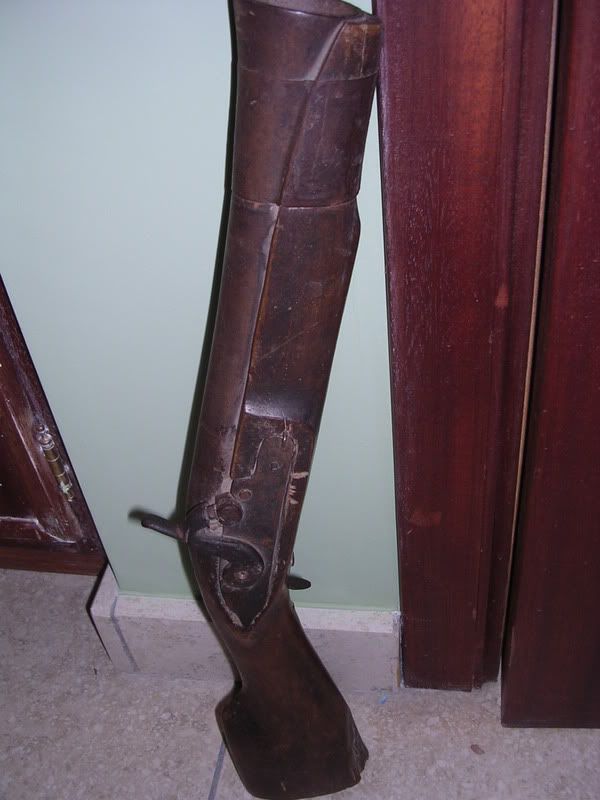  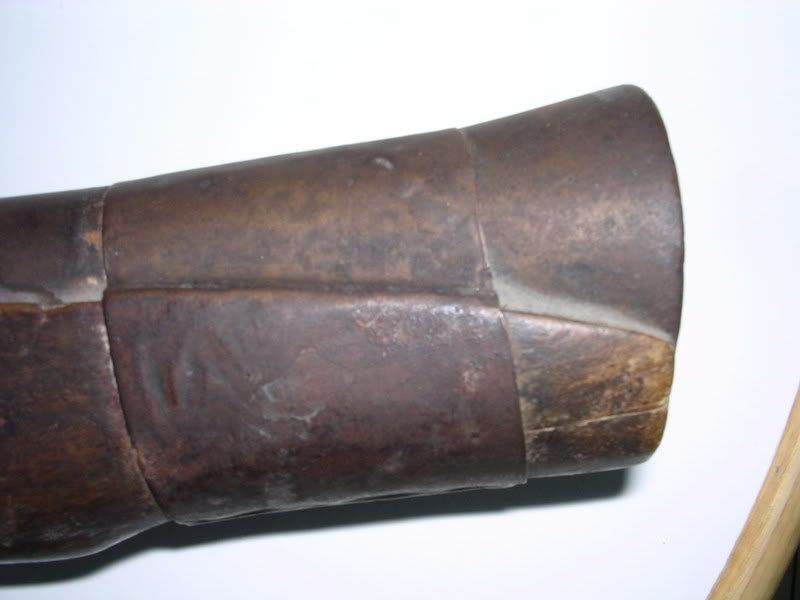
|
|
|

|
|
|
#18 |
|
(deceased)
Join Date: Dec 2004
Location: Portugal
Posts: 9,694
|
Hi Freddy
Is the action working ? Is 48 cms. the total length ? Fernando |
|
|

|
|
|
#19 |
|
Member
Join Date: Dec 2004
Location: Sint-Amandsberg (near Ghent, Belgium)
Posts: 830
|
Yes, the total length is 48 cm. Quite a compact piece.
It's possible to pull the hammer back and from time to time it reacts when you pull the trigger. Unfortunately, some barbarian  put a nail in the hole where the percussion cap had to be placed to ignite the powder. put a nail in the hole where the percussion cap had to be placed to ignite the powder.But still, it looks nice on my wall. |
|
|

|
|
|
#20 |
|
(deceased)
Join Date: Dec 2004
Location: Portugal
Posts: 9,694
|
It seems as piracy chronicles are traditionaly fancifull, and rather dificult to discern which were the actual devices tose guys used in action. According to Exquemelin's way of portraying his favorites, those operating in the Antilles, the main weapon was indeed a short piece, practical for boarding melee.
On the other hand Teach ( Black beard ) can be seen portraied in "speciality books" with various pistols ( three according to chronists ) and a full sized sword ... and two burning priming cords pending from his hat  William Kidd is a figure that still sustains lots of mystic as, just the other day, certain researchers went back to the files to try and determine that Kidd's condemnation was a judicial error  . .All this and much more comes in an interesting book about Piracy and Corso from all times, published in 1997 ( ISBN 972-759-044-6 ). A pitty that the weapons used are the least contemplated part. |
|
|

|
|
|
#21 | |
|
(deceased)
Join Date: Dec 2004
Location: Portugal
Posts: 9,694
|
Quote:
 I wouldn't mind fixing that problem of the nail stuck in the fire hole  . .
|
|
|
|

|
|
|
#22 |
|
Arms Historian
Join Date: Dec 2004
Location: Route 66
Posts: 10,730
|
Fernando, thank you for the great posts of these illustrations! These are great for point of reference as we look at how artists and illustrators perceived the weapons carried by the pirates, and we wonder how accurate or fanciful these renderings are.
I think poor Captain Kidd really got a bad rap! All the best, Jim |
|
|

|
|
|
#23 |
|
Member
Join Date: Mar 2006
Location: Room 101, Glos. UK
Posts: 4,263
|
as mentioned by jim in post no. 1 there is more than just the caribbean,
the indonesian/malayan/phillipines were (and still are) famous for their piratical endeavours. the sea dyaks (iban) were amoungst those feared eastern pirates, and their parangs were ideal for close encounters of the maritime kind, they were especially fond of making sure their clients stayed with them for a long time, but tended to make them a bit more portable by just taking the heads back as guests. limited the conversation a bit. my sea dyak parang of Langgai Tinggang type (looks late 20c)  19" blade, 1/4" at grip, distal tapered to point, 2 brass 'dot' blade inserts near tip and 1 in the krowit. crudely carved wood grip & scabbard with fancy rattanwork... i suspect my klewang with the fur covered (90% of fur is gone) leather scabbard & brass guard & grip (leather wound) was also of piratical origin. 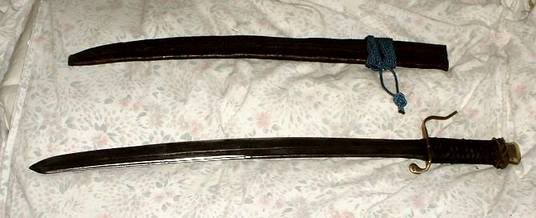 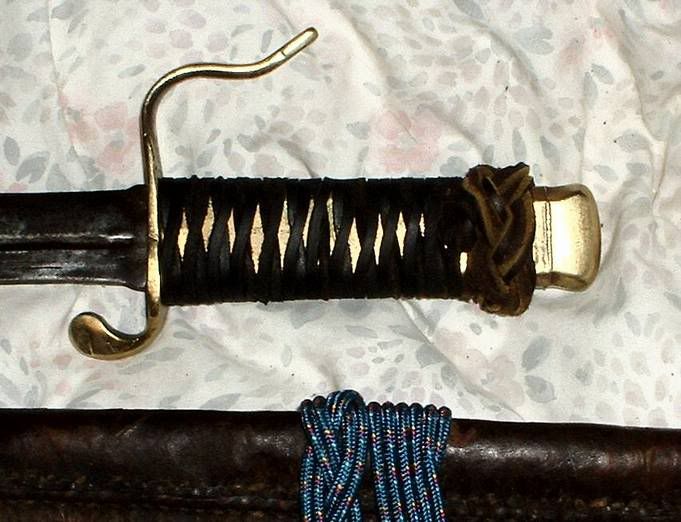 19.5" blade, 3/8" at grip (1/4" at 1" from grip) distal taper to 1/8" at tip, concaved blade spine to halfway, then spine is grooved either side to the tip, single fuller runs the full length. blade tip appears to have been shortened. Last edited by kronckew; 25th December 2007 at 07:46 AM. |
|
|

|
|
|
#24 |
|
Arms Historian
Join Date: Dec 2004
Location: Route 66
Posts: 10,730
|
Thank you for posting these Kronckew! The sea Dyaks were definitely one of the groups from those regions I was referring to. The parang (I believe often termed also 'mandau') is not surprisingly included in some references I have seen showing groupings of a variety of 'pirate' weapons. I am not sure of the range of the Sea Dyaks beyond thier home regions, but I would not be surprised if some of them joined other pirate crews on individual basis. These parangs might have been adopted by crewmen of ships that visited these regions as well, which seems a plausible speculation.
The 'klewang' you show is also very interesting, especially the wrapped grip and mount components which appear of Japanese katana style. It seems that in discussions some time ago concerning Japanese influences on the weapons in SE Asia, it was noted that many groups of river pirates in the rivers deep inland in SE Asia were comprised of many Japanese. I vaguely recall even a katana type sword captioned as from India, though I had serious reservations on complete acceptance of that attribution. The hilt on this example with the upward and downward quillons on the guard of course also reflects Chinese sidearms including those attributed to Chinese river pirates. Those groups were still extremely active well into the 20th century and a great movie that included that topic was "The Sand Pebbles" with Steve McQueen. I do not recall specifically details such as weapons from the movie, but thought the subject worthy of note. All best regards, Jim |
|
|

|
|
|
#25 |
|
Member
Join Date: Mar 2006
Location: Room 101, Glos. UK
Posts: 4,263
|
hi jim, interesting thoughts on the one that was billed as a 'klewang' by it's previous owner who mentioned it might have been confiscated from pirates. could be chinese with the point reground. here we go using terms that just mean 'sword' locally. it was purported to have come from malaysia.
 i also have this bornean (?) parang on the way from birmingham*, 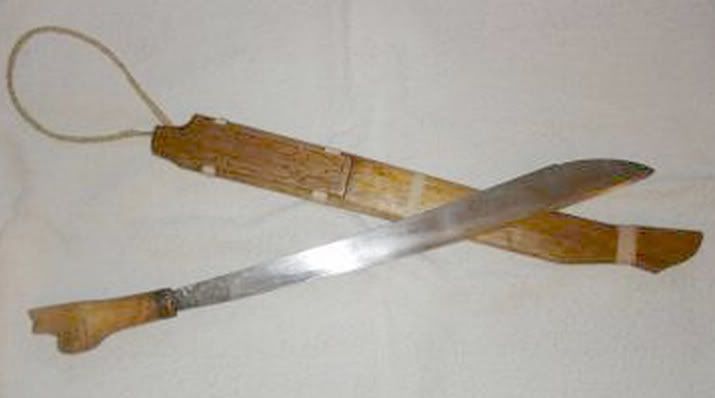 while it looks a bit like a dyak parang ilang, it's apparently not a mandau (double knife). the blade supposedly is from around 1900, but the dress has been restored. will have better idea when it arrives (would have been easier to drive the hour up there, but it's coming via Royal Mail  ). ).* the UK one, the Alabama one woulda been a two hour trip from home in morgan county. 
|
|
|

|
|
|
#26 |
|
(deceased)
Join Date: Dec 2004
Location: Portugal
Posts: 9,694
|
Also pistols like this one are said to have been were used by pirates ... those with more wealth.
This is a Queen Anne pistol, assumedly from the the XVIII century. |
|
|

|
|
|
#27 |
|
Member
Join Date: Oct 2007
Posts: 2,818
|
A long time coming with these pics as with a lot of threads I do wish to add my bit too. Below are a series of engravings from a time life book that should give a good indications of the weapons carried by them there pirates arrg!!
Also a great read for anyone interest in these pirate stories and discoveries from the bottom of the sea would be any books by Barry Clifford, the research and insight into the life and times of these misplaced men is amazing. I beleive if you right click and attempt to save the image it will reveal the name of the pictured Pirate for those who are interested. There is also an image of weapons of the day and it is said all these weapons are carried at once for most excursions as they had to be a walking arsenal but both long arms were most likely not carried at the same time. As seen in one engraving 6 more more pistols were carried by some. Gav |
|
|

|
|
|
#28 |
|
(deceased)
Join Date: Feb 2005
Location: Centerville, Kansas
Posts: 2,196
|
Well I can't say that this was ever on a ship but I do think loaded with nails or shot it would have been quite helpful if you had to clear the decks.
  It was originally a flint lock that was later converted to musket cap. It was originally a flint lock that was later converted to musket cap.Total length is 30 inches Barrel is 16-1/2 inches Bore about 3/4 inch Robert |
|
|

|
|
|
#29 |
|
Arms Historian
Join Date: Dec 2004
Location: Route 66
Posts: 10,730
|
Hi Gav,
Thank you for posting those illustrations out of "The Pirates". That Time-Life book has some of the greatest photos and illustrations, and really brought things to life when reading about these scoundrels  Its great to have those pictures here to bring that dimension to the discussion while we examine the many different types of weapons actually used by them. While those illustrated are pretty much the standard forms estimated in use, we have seen that in reality there was an amazingly wide spectrum of forms from equally widely ranged cultural spheres. Good suggestion on Barry Clifford, especially on the discovery of the "Whydah". It seems that among the artifacts discovered, I believe there was the remains of one of the pistols with ribbon still festooned to it. Interesting to think of these pre-revolver days  with one gun having six shots instead of having to wear six pistols! with one gun having six shots instead of having to wear six pistols! Thanks for the musket Robert, quite literally a hand held cannon! No doubt, as you have noted, it would clear a deck pretty quick! All best regards, Jim |
|
|

|
|
|
#30 |
|
Member
Join Date: Dec 2006
Location: Idaho, USA
Posts: 230
|
Carrying 6 or more single shot pistols was quite a load, but Jesse James and others in Quantrill's Raiders were known to carry more than 20 revolvers on and about them and their horses on raids. That was a lot of firepower in the 1860's! On shipboard one of the best guns was the swivel gun ususally mounted on both sides of the bridge. I'm building one now and when it is finished I'll post it. It has a 1.75 inch bore and I have test fired it with shot. Absolutely devastating out to 25 yards.
Shiver me timbers bbjw |
|
|

|
 |
|
|